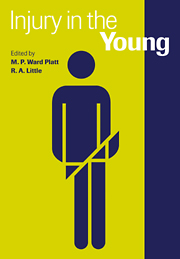Book contents
- Frontmatter
- Contents
- List of contributors
- Editors' Preface
- 1 The epidemiology of trauma involving children
- 2 Emergency room requirements for children
- 3 Child deaths in Accident and Emergency
- 4 Immediate life support
- 5 Evaluation of injury in children
- 6 Injuries of the developing brain
- 7 Wound healing in children
- 8 The lung after injury in children
- 9 Metabolic and endocrine stress responses to surgery
- 10 Head injury in children
- 11 Near drowning
- 12 The acute response to burn injury in children
- 13 Nutritional support of the severely burned child
- 14 Recovery, rehabilitation and the neuropsychological sequelae of head injury
- 15 Children's rights and child protection
- Index
8 - The lung after injury in children
Published online by Cambridge University Press: 18 September 2009
- Frontmatter
- Contents
- List of contributors
- Editors' Preface
- 1 The epidemiology of trauma involving children
- 2 Emergency room requirements for children
- 3 Child deaths in Accident and Emergency
- 4 Immediate life support
- 5 Evaluation of injury in children
- 6 Injuries of the developing brain
- 7 Wound healing in children
- 8 The lung after injury in children
- 9 Metabolic and endocrine stress responses to surgery
- 10 Head injury in children
- 11 Near drowning
- 12 The acute response to burn injury in children
- 13 Nutritional support of the severely burned child
- 14 Recovery, rehabilitation and the neuropsychological sequelae of head injury
- 15 Children's rights and child protection
- Index
Summary
Introduction
The paediatric lung is not a fully developed organ. From birth to the age of 8 years the number of alveoli in the lungs increase from 20 to 300 million. Lung growth after 8 years of age is due to an increase in alveolar size alone (Phelan et al., 1994). Structural immaturity of the lung in early childhood could result in an increased vulnerability to injury. Alternatively, an increased capacity for repair and regeneration may limit the degree of damage. Given the same insult, however, the mechanisms of lung tissue damage are often identical in the adult and child. In this chapter I describe how oxidants, inflammatory cells and oedema injure the lung. The role of these mechanisms in paediatric neurogenic pulmonary oedema, adult respiratory distress syndrome in children and neonatal chronic lung disease are reviewed.
Mechanisms of pulmonary injury
Oxidant injury
Pulmonary oxidant injury occurs when the rate of production of oxygen-derived reactive species (free radicals) overwhelms pulmonary antioxidant defences. If not removed immediately, free radicals oxidatively damage all components of cells. The key oxidants are the superoxide (O2-) and hydroxyl (OH.) radicals and the main pulmonary antioxidants are superoxide dismutase, catalase and glutathione. During normal cellular respiration some degree of intracellular free radical production occurs. The pulmonary production of intracellular and extracellular free radicals is substantially increased by high concentrations of oxygen, reperfusion injury (Jenkinson et al., 1988) and activated neutrophils (Farber et al., 1990).
- Type
- Chapter
- Information
- Injury in the Young , pp. 107 - 127Publisher: Cambridge University PressPrint publication year: 1998



